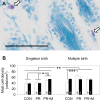Late-gestation maternal dietary methyl donor and cofactor supplementation in sheep partially reverses protection against allergic sensitization by IUGR
- PMID: 28978515
- PMCID: PMC5866368
- DOI: 10.1152/ajpregu.00549.2016
Late-gestation maternal dietary methyl donor and cofactor supplementation in sheep partially reverses protection against allergic sensitization by IUGR
Abstract
Perinatal exposures are associated with altered risks of childhood allergy. Human studies and our previous work suggest that restricted growth in utero (IUGR) is protective against allergic disease. The mechanisms are not clearly defined, but reduced fetal abundance and altered metabolism of methyl donors are hypothesized as possible underlying mechanisms. Therefore, we examined whether late-gestation maternal dietary methyl donor and cofactor supplementation of the placentally restricted (PR) sheep pregnancy would reverse allergic protection in progeny. Allergic outcomes were compared between progeny from control pregnancies (CON; n = 49), from PR pregnancies without intervention (PR; n = 28), and from PR pregnancies where the dam was fed a methyl donor plus cofactor supplement from day 120 of pregnancy until delivery (PR + Methyl; n = 25). Both PR and PR + Methyl progeny were smaller than CON; supplementation did not alter birth size. PR was protective against cutaneous hypersensitivity responses to ovalbumin (OVA; P < 0.01 in singletons). Cutaneous hypersensitivity responses to OVA in PR + Methyl progeny were intermediate to and not different from the responses of CON and PR sheep. Cutaneous hypersensitivity responses to house dust mites did not differ between treatments. In singleton progeny, upper dermal mast cell density was greater in PR + Methyl than in PR or CON (each P < 0.05). The differences in the cutaneous allergic response were not explained by treatment effects on circulating immune cells or antibodies. Our results suggest that mechanisms underlying in utero programming of allergic susceptibility by IUGR and methyl donor availability may differ and imply that late-gestation methyl donor supplementation may increase allergy risk.
Keywords: animal models; fetal growth; folic acid; intrauterine growth restriction; mast cells; methyl donors.
Figures



References
Publication types
MeSH terms
Substances
Grants and funding
LinkOut - more resources
Full Text Sources
Other Literature Sources
Medical
Research Materials

